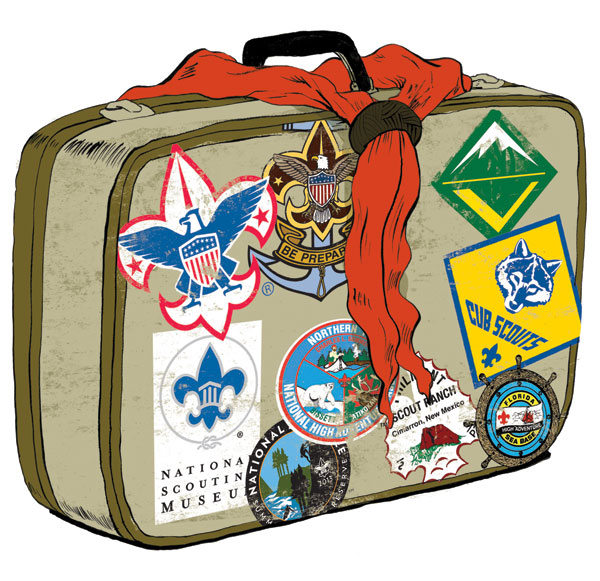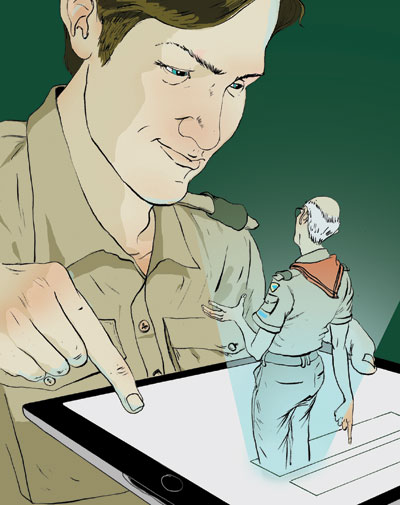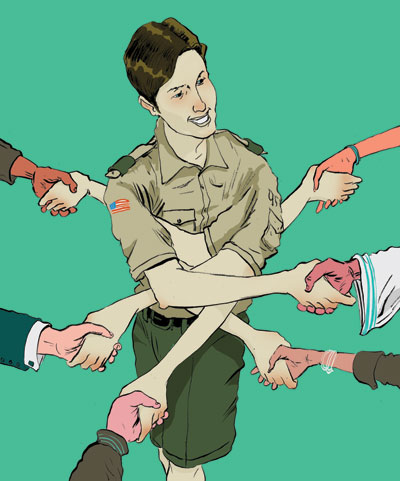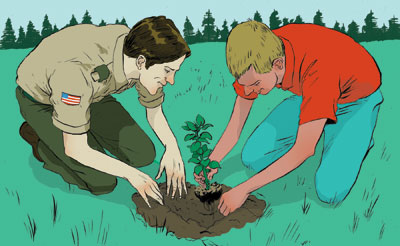The get-started guide for new Scouting leaders

WELCOME TO SCOUTING! You’re joining a force of volunteers a million strong, some who started in Scouting before you were born (see tip No. 38). Yet you may be uniquely qualified to have a powerfully positive impact on the young people in your unit (see tip No. 43). No pressure, huh?
We at Scouting magazine have been where you are, and we understand just how intimidating the job can be. So we created this handy guide to help you through the first months of your Scouting career. Half of the tips below stem from our own experience; the other half come from Scouters across the country who responded to survey questions on our Facebook page (see tip No. 20). We appreciate their input and look forward to the day that you, too, start sharing your wisdom with Scouting’s next crop of rookie leaders.
But, we also realize that our readers have plenty of additional advice to share, too. That’s why we ask that—if you see something we’ve missed—post your own suggestions for new leaders below. We’ll be gathering the comments you add and then on Oct. 1, we’ll announce our favorites. Plus, we’ll select 10 random commenters to receive a $10 Supply Group gift card as a thanks for sharing your advice.
To be a part of the gift-card drawing, you must submit your comment before Sept. 30. We’ll announce our winners on Oct. 1.
 1. Add to Bookmarks. MyScouting (myscouting.org) is the entry point on the BSA Web site for all sorts of Web-based activities, including training, Internet advancement, and registration for national events. Signing up is simple, and there’s a tutorial if you get stuck. As soon as possible, add your member ID to your profile so you get credit for online training.
1. Add to Bookmarks. MyScouting (myscouting.org) is the entry point on the BSA Web site for all sorts of Web-based activities, including training, Internet advancement, and registration for national events. Signing up is simple, and there’s a tutorial if you get stuck. As soon as possible, add your member ID to your profile so you get credit for online training.2. Become an Alum. Even if you’re new, you qualify for the BSA Alumni program (bsaalumni.org). Why sign up? Four words: free bugle-call ringtones.
3. All in the Timing. Get all your Scouting dates on your family calendar and fix any conflicts. Nothing’s worse than having to cancel a den meeting on your wedding anniversary (except not canceling a den meeting on your wedding anniversary).
4. Training Basics. Every Scout deserves a trained leader, and every leader deserves to be trained. The basic-training sequence has four phases: Fast Start, Youth Protection (the required child-abuse prevention and detection course), This Is Scouting (an overview of the Scouting program), and position-specific training. Learn more, including which courses are available online, at bit.ly/BSAtraining. Remember, you must complete Youth Protection training before you can register as a leader.
5. You are Here. As a volunteer, you can earn all sorts of awards, most of which are represented by those knots you see on veteran leaders’ uniforms. Find out which awards are available for your position and start tracking your progress. Learn about all the knots by visiting bit.ly/knowyourknots.
6. Know Then Sew. When you’re properly uniformed, you set an example for your Scouts and have a place to display the awards you receive (patches aren’t just for the boys). Yes, uniforms can be expensive, but many packs, troops, and crews have closets of “experienced” uniforms that you may use. Before you start sewing on patches, grab a uniform inspection sheet from bit.ly/uniforminspection and get things in the right place the first time. Don’t like to sew? Try Badge Magic (bit.ly/badgemagickit).
7. Get to Know Your Scouts … You’ll be spending lots of time with them, so find out where they go to school, what they like and dislike, and how you can best contact them (phone, e-mail, Facebook, etc.).
8. … and their Parents. What are their hobbies and talents? Who can haul the boys to camp? Any Eagle Scouts in the group? Give every parent a little job and your job won’t seem so big.
9. Then Check Out ScoutParents. Speaking of parents, surf over to scoutparents.org for extensive information on how Scouting benefits parents and families, not just kids. There’s even a free e-book about the subject on the site.
10. Nights at the Roundtable. Here’s where you’ll find a bunch of Scouters who’ve been in your shoes and are eager to help you be successful. Some of the best discussions happen after the closing, so plan to stay late. Check with your unit leader or council office for dates and locations.
11. Sites for Your Eyes. Another great source for Scouting information is the Internet. You can find Scouting magazine online at scoutingmagazine.org. Ask people in your unit or district for their favorite online discussion groups, blogs, and podcasts. And be sure to bookmark Scouting’s blog: blog.scoutingmagazine.org.
12. Less Taxing. If you itemize your taxes, you can deduct the cost of your uniforms and the miles you drive as a volunteer. You’ll need good records, so start a receipt file and mileage log. For more information, visit bit.ly/scoutingwriteoffs or consult your tax adviser.
13. Get a Life—or snag your son’s copy when he’s not looking. Boys’ Life magazine content aligns with pack and troop programs, and the jokes are always good for a laugh. For a quick game, create a scavenger hunt where boys look for specific words or pictures in the current issue. Learn more about BL at boyslife.org.
 14. Meet and Greet: STEP 1. Seek out your chartered organization representative, the volunteer who oversees Scouting at your chartered organization (the school, community group, or religious institution that sponsors your unit). Ask how Scouting supports the organization’s mission and what your unit can do to help. This is especially important if you’re the unit leader or committee chair.
14. Meet and Greet: STEP 1. Seek out your chartered organization representative, the volunteer who oversees Scouting at your chartered organization (the school, community group, or religious institution that sponsors your unit). Ask how Scouting supports the organization’s mission and what your unit can do to help. This is especially important if you’re the unit leader or committee chair.15. Meet and Greet: STEP 2. Seek out your district executive and unit commissioner. The DE is the professional Scouter who oversees Scouting in your community; the commissioner is an experienced volunteer charged with supporting your unit. Their goal is to make your unit successful, and they have access to lots of useful resources.
16. Meet and Greet: STEP 3. Find a mentor in your district who holds the same position as you. Meet for coffee to discuss any challenges you’re facing, then visit one of your mentor’s meetings to see him or her in action.
17. Get to Philmont—Pronto! Philmont Scout Ranch near Cimarron, N.M., is the world’s largest youth camping facility. It’s also the BSA’s national volunteer training center. Every summer, the Philmont Training Center offers dozens of weeklong conferences for Scouters of all experience levels. Best of all, your spouse and children can participate in great family programs while you’re in class. Details at philmontscoutranch.org/ptc.aspx.
18. KISMIF? OMG! Quick! What do the following acronyms and initialisms mean?
COPE KISMIF NOAC WOSM
If you don’t know NESA from NOAC, bookmark the Language of Scouting website (scouting.org/scoutsource/Media/LOS.aspx). You’ll never be at a loss when veteran Scouters start tossing jargon around. (Find the answers to this in your September-October 2012 issue of Scouting magazine.)19. On the Map. Have you visited Beascout.org? This spiffy new unit locator uses Google Maps to help prospective Scouts find you. The BSA’s Beascout.org is so new that many veterans don’t know about it. Introduce your unit to it, and you’ll no longer be the newbie.
20. Do You Like Us? You are on Facebook, aren’t you? Then “like” the pages for the BSA and Scouting and Boys’ Life magazines. When you do, you’ll get the latest Scouting news. Find us at facebook.com/scoutingmagazine.
21. Find Direction. What do you want to accomplish this year or before you leave Scouting? (Which we hope won’t be this year.) Write down your goals and paste them in your leader book to help you stay on track.
22. Catch Up on Some Reading. Read the appropriate youth and adult handbooks that relate to your position. If you’re a Wolf den leader, get the Wolf Cub Scout Handbook and Cub Scout Leader Book. If you’re an assistant Scoutmaster, get the Boy Scout Handbook and Scoutmaster Handbook. If you’re a Venturing Advisor, get the Venturing/Ranger Handbook and the Venturing Leader Manual. If you’re a … Well, you get the idea.
23. Reach the Summit. The Summit Bechtel Reserve in West Virginia promises a world of excitement for older Scouts and Venturers. You can’t visit until next summer, but the Web site is open for business now: summit.scouting.org.
24. Start Your Journey. Journey to Excellence is the BSA’s performance recognition program for units, districts, and councils. JTE, which replaces the Quality Unit program, measures advancement, activities, leader training, and more. Visit bit.ly/BSAjourneytoexcellence to learn about the specific goals for your type of unit. Then ask your unit leader about your unit’s progress toward Bronze, Silver, or Gold recognition.
25. Meet a Founder. Scouting’s founder, Robert Baden-Powell, died in 1941, but his spirit is alive and well today. You can read many of his books, including Scouting for Boys (the first Boy Scout handbook), at bit.ly/bpowell.
IDEAS FROM SCOUTERS
For Working With Scouts
26. The most powerful words in the world are, “That sounds cool. Make it happen.” —Cassie Johnson
27. Be willing to do whatever you are asking the boys to do. They will be more willing to participate if you make a fool of yourself first. —Stephanie Gourley
28. Listen to the Scouts. They are smarter than you think. —Andrew O’Connor
29. Scouts just want to have fun and learn. They never have an agenda. —Skip Tamke
30. Trust your older Scouts—but verify! —Tim Hagey
For Working With Families
 31. There are never enough volunteers. Recruit those parents from the day they sign up their kid! —Jane Hansen
31. There are never enough volunteers. Recruit those parents from the day they sign up their kid! —Jane Hansen32. Share as many details about an event as you can before a family has to commit. That way they have every opportunity to make sure it is right for them. —Shelli Smith Luna
33. Stick to your schedule. Families will come to understand it’s easier to work into a planned schedule than to pull things together at the last minute. —Laurie Good Kautz
34. Some kids have a very structured home life; others are the opposite. Make your den rules apparent from the beginning and stick with them. —Michelle Cianflone Flynn
35. When someone asks you “How can I help?” you’d better have an answer; otherwise, they may never ask again. —Dave Ruiz
For Getting Up to Speed, Fast
36. Go to roundtable, learn online, and make friends. —Christine Needham Martin
37. Don’t wait to get all of your basic training done. —Kirsten Johnson
38. At your first roundtable or training, look for the person with the most knots on his or her Scout shirt. Knots indicate experience and knowledge, and those individuals are a wealth of resources and contacts—and they are free. —Lindsay Foster
39. Talk to other Scouters. At summer camp or other council or district events, go to other campsites and talk to the Scouters there. —Chuck Pint
40. Ask questions. Most leaders are willing to help, but they don’t want to make you uncomfortable or overwhelmed. —Aileen Sheehan Masone
For Measuring Success
41. Success as a Scouter can be measured in grins and laughter. —Tom Osen
42. Do you go home after a meeting tired but smiling because you saw a boy do something big for himself that most people, even his parents, probably would never notice? That’s when you know you’ve done it right. —Phil Peck
43. Success is seeing your Scouts following the morals and ethics learned in Scouting and putting them into practice with enthusiasm. —Ronald Pierantozzi
44. Success is seeing the smiles of the boys as they learn new things and watching them come back every week eagerly anticipating more. —Charles Nesloney
45. Wait 15 to 20 years to see what kind of men they become. Then you’ll know if you were successful. —Calvin Gray
Miscellaneous Tips
46. There are so many Scouting urban legends out there. (“The left-handed handshake has been banned because it’s a secret sign.”) If someone says something that seems odd or strange, ask where it can be found in print. —Michelle Matowski
47. Plan for more than you can do in an activity or meeting. —Bradley White-Findeisen
48. No one, especially the Scouts, cares what you know. What is important is what you do. —Joe Julio
49. Learn to listen, not lecture; to joke, not judge; and to laugh whenever possible. —Dan Hartnett
50. In volunteering, you are truly receiving a gift. The more time and effort you set aside for your Scouts, the greater the gift you’ll receive in return. —Anthony Daniel Thorne
No comments:
Post a Comment